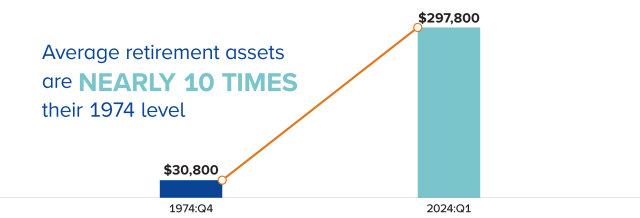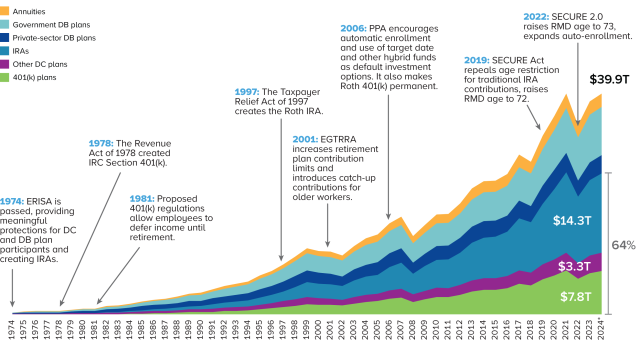ICI Viewpoints
Revolutionizing Retirement
Adjusted for inflation, average retirement assets per US household are nearly 10 times what they were 50 years ago. That surge in wealth has been propelled largely by IRAs, 401(k)s, and similar plans, which provide retirement security for families of all backgrounds and income levels.
Given the prominence of these accounts in people’s financial lives, it’s easy to forget that saving for retirement wasn’t always so seamless and that the opportunity to build wealth wasn’t always so accessible to everyday Americans.

Note: Average retirement assets per household in constant 2024:Q1 dollars.
Sources: Investment Company Institute, Federal Reserve Board, Bureau of Labor Statistics, and US Census Bureau
In truth, the success of the US retirement system stems from industry innovation, competition, and a series of smart policy reforms reflecting an enduring commitment to long-term savers. Today, those reforms are bearing more fruit than ever, with retirement account balances and contribution rates at record highs, a growing share of young households owning retirement accounts, and significant income replacement for retirees.
Let’s Rewind
In 1972, NBC aired an award-winning special, Pensions: The Broken Promise. At a time when many of those fortunate enough to be covered by defined benefit (DB) plans ultimately couldn’t collect pensions—due to company closures, rigid eligibility requirements, or governance problems like those involved in the infamous Studebaker-Packard plan—the special spotlighted the public’s growing frustration with the retirement system. Americans demanded change, and they would soon get it.
Just two years later, with near unanimous support among lawmakers, Congress passed the Employee Retirement Income Security Act of 1974 (ERISA), which was signed into law on Labor Day that year. In addition to establishing safeguards and minimum standards for DB plans, the law created a powerful new tool for retirement saving: IRAs.
The traditional IRA, and later the Roth IRA, gave American workers a tax-advantaged way to save for retirement, one that existed outside the confines of their job. Several years after ERISA’s passage, a provision in the tax code gave rise to 401(k)s. These plans, along with similarly styled plans for the nonprofit and public sectors, would not only extend savings opportunities to more workers but also magnify Americans’ financial possibilities in retirement.
The Rise of Account-Based Savings
Unlike traditional DB plans, IRAs and 401(k)s let Americans put money directly into mutual funds and other investment products, enabling them to generate investment gains for themselves and build a nest egg on their own terms. And whereas some DB plans effectively penalize workers for changing employers early in their tenure, 401(k)s and similar plans make it easy for workers to seize better career opportunities elsewhere while keeping their hard-earned retirement savings. When they do change jobs, Americans often use IRAs to easily transfer and maintain the tax treatment of their workplace retirement assets.
Attracted by the flexibility, tax benefits, and wealth-building potential of IRAs and 401(k)s, Americans quickly took advantage of them to help them reach their long-term financial goals. By 1990, assets in IRAs, 401(k)s, and similar plans had eclipsed $1.5 trillion. Twenty-four years later, that figure that is now above $25 trillion.[1]
Account-Based Saving Is the Fastest-Growing Part of the US Retirement System
US retirement assets (trillions of US dollars) and ICI summary of events and legislative changes, 1974–2024*

* Data for 2024 are as of the end of March.
Note: For definitions of plan categories and a complete list of data sources, see Tables 1 and 6 in “The US Retirement Market, First Quarter 2024.” Some data are estimated.
Those trillions of dollars translate into meaningful income for long-term retirement savers. Moreover, since ERISA’s passage, income from retirement plans—including IRAs, 401(k)s, and similar plans as well as DB plans—has increased for all income groups.

Building on a Strong Base
As IRAs and 401(k)s took hold, Congress passed bipartisan legislation to encourage the innovations and best practices emerging in the market and increase pathways to saving, such as automatic enrollment (PPA and SECURE 2.0), the creation of Roth IRAs (TRA ’97), expanded contribution opportunities for older workers through catch-up contributions (EGTRRA), and the removal of the age limit for traditional IRA contributions (SECURE).
Those laws are paying off. Contribution rates into 401(k) plans have reached record highs. And younger Americans are participating in retirement plans and IRAs and saving more than previous generations did at the same stages of life.
More Progress on the Horizon
As the United States navigates fiscal challenges and an uncertain economy, policymakers should act to preserve what they have empowered so far. The retirement reforms set in motion 50 years ago were a critical response to the needs of everyday Americans, and the resulting retirement system today speaks for itself.
IRAs and 401(k)s have fundamentally transformed the US retirement landscape, sparking remarkable growth in households’ retirement nest eggs and giving Americans greater control over their financial futures. With even more Americans in line to participate in these plans, the retirement revolution is still going strong.
Note
Sarah Holden is the Senior Director of Retirement and Investor Research at ICI.
Elena Barone Chism is Deputy General Counsel, Retirement Policy, at ICI.
Adam Sands is a Senior Writer at ICI.
